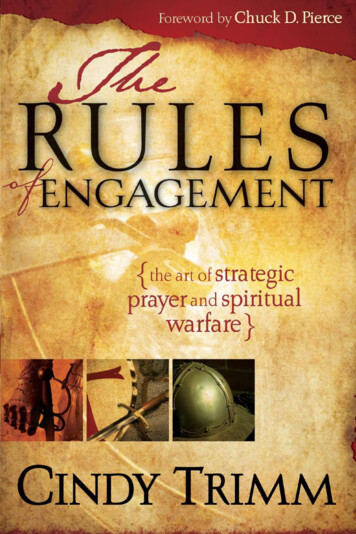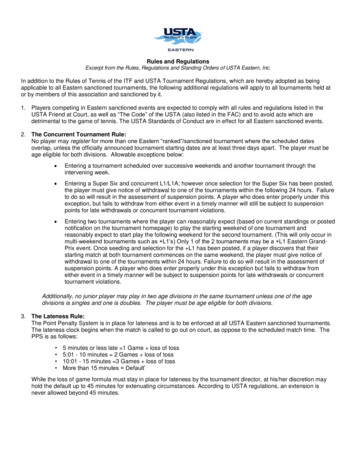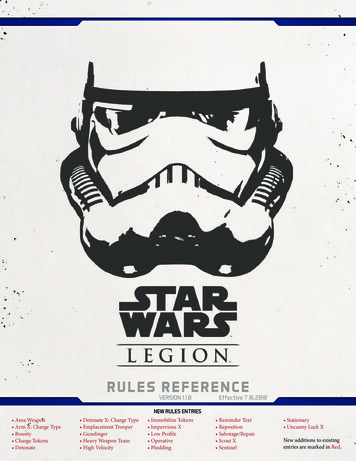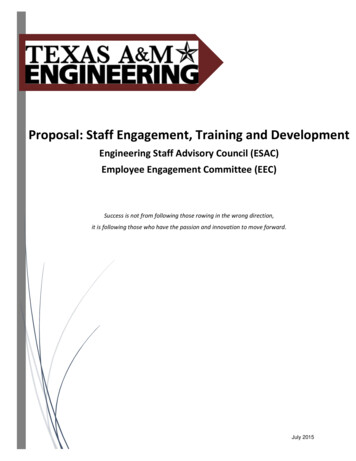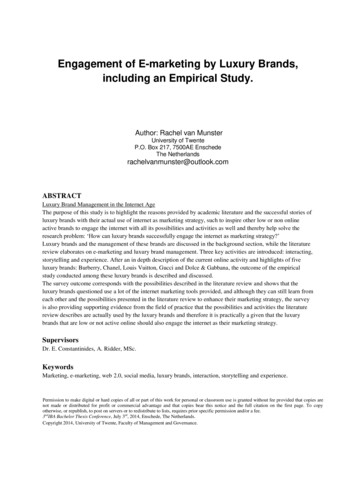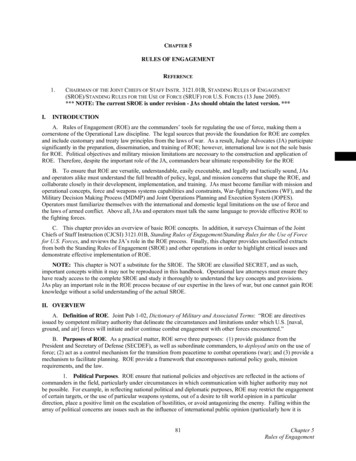
Transcription
CHAPTER 5RULES OF ENGAGEMENTREFERENCE1.I.CHAIRMAN OF THE JOINT CHIEFS OF STAFF INSTR. 3121.01B, STANDING RULES OF ENGAGEMENT(SROE)/STANDING RULES FOR THE USE OF FORCE (SRUF) FOR U.S. FORCES (13 June 2005).*** NOTE: The current SROE is under revision - JAs should obtain the latest version. ***INTRODUCTIONA. Rules of Engagement (ROE) are the commanders’ tools for regulating the use of force, making them acornerstone of the Operational Law discipline. The legal sources that provide the foundation for ROE are complexand include customary and treaty law principles from the laws of war. As a result, Judge Advocates (JA) participatesignificantly in the preparation, dissemination, and training of ROE; however, international law is not the sole basisfor ROE. Political objectives and military mission limitations are necessary to the construction and application ofROE. Therefore, despite the important role of the JA, commanders bear ultimate responsibility for the ROEB. To ensure that ROE are versatile, understandable, easily executable, and legally and tactically sound, JAsand operators alike must understand the full breadth of policy, legal, and mission concerns that shape the ROE, andcollaborate closely in their development, implementation, and training. JAs must become familiar with mission andoperational concepts, force and weapons systems capabilities and constraints, War-fighting Functions (WF), and theMilitary Decision Making Process (MDMP) and Joint Operations Planning and Execution System (JOPES).Operators must familiarize themselves with the international and domestic legal limitations on the use of force andthe laws of armed conflict. Above all, JAs and operators must talk the same language to provide effective ROE tothe fighting forces.C. This chapter provides an overview of basic ROE concepts. In addition, it surveys Chairman of the JointChiefs of Staff Instruction (CJCSI) 3121.01B, Standing Rules of Engagement/Standing Rules for the Use of Forcefor U.S. Forces, and reviews the JA’s role in the ROE process. Finally, this chapter provides unclassified extractsfrom both the Standing Rules of Engagement (SROE) and other operations in order to highlight critical issues anddemonstrate effective implementation of ROE.NOTE: This chapter is NOT a substitute for the SROE. The SROE are classified SECRET, and as such,important concepts within it may not be reproduced in this handbook. Operational law attorneys must ensure theyhave ready access to the complete SROE and study it thoroughly to understand the key concepts and provisions.JAs play an important role in the ROE process because of our expertise in the laws of war, but one cannot gain ROEknowledge without a solid understanding of the actual SROE.II. OVERVIEWA. Definition of ROE. Joint Pub 1-02, Dictionary of Military and Associated Terms: “ROE are directivesissued by competent military authority that delineate the circumstances and limitations under which U.S. [naval,ground, and air] forces will initiate and/or continue combat engagement with other forces encountered.”B. Purposes of ROE. As a practical matter, ROE serve three purposes: (1) provide guidance from thePresident and Secretary of Defense (SECDEF), as well as subordinate commanders, to deployed units on the use offorce; (2) act as a control mechanism for the transition from peacetime to combat operations (war); and (3) provide amechanism to facilitate planning. ROE provide a framework that encompasses national policy goals, missionrequirements, and the law.1. Political Purposes. ROE ensure that national policies and objectives are reflected in the actions ofcommanders in the field, particularly under circumstances in which communication with higher authority may notbe possible. For example, in reflecting national political and diplomatic purposes, ROE may restrict the engagementof certain targets, or the use of particular weapons systems, out of a desire to tilt world opinion in a particulardirection, place a positive limit on the escalation of hostilities, or avoid antagonizing the enemy. Falling within thearray of political concerns are issues such as the influence of international public opinion (particularly how it is81Chapter 5Rules of Engagement
affected by media coverage of a specific operation), the effect of host country law, and the content of status of forcesagreements (SOFA) with the United States.2. Military Purposes. ROE provide parameters within which the commander must operate toaccomplish his or her assigned mission:a. ROE provide a limit on operations and ensure that U.S. actions do not trigger undesired escalation,i.e., forcing a potential opponent into a “self-defense” response.b. ROE may regulate a commander’s capability to influence a military action by granting orwithholding the authority to use particular weapons systems or tactics.c. ROE may also reemphasize the scope of a mission. Units deployed overseas for training exercisesmay be limited to use of force only in self-defense, reinforcing the training rather than combat nature of the mission.3. Legal Purposes. ROE provide restraints on a commander’s actions, consistent with both domestic andinternational laws, and may, under certain circumstances, impose greater restrictions than those required by the law.For many missions, particularly peace operations, the mission is stated in a document such as a UN Security CouncilResolution (UNSCR), e.g., UNSCR 940 in Haiti, UNSCR 1031 in Bosnia, or UNSCR 1973 in Libya. TheseSecurity Council Resolutions also detail the scope of force authorized to accomplish the purpose stated therein.Mission limits or constraints may also be contained in mission warning or execute orders. Accordingly,commanders must be intimately familiar with the legal basis for their mission. Commanders may also issue ROE toreinforce certain principles of the Law of Armed Conflict (LOAC), such as prohibitions on the destruction ofreligious or cultural property or minimization of injury to civilians and civilian property.III. CJCS STANDING RULES OF ENGAGEMENTA. Overview. The current SROE went into effect on 13 June 2005, the result of a review and revision of theprevious 2000 and 1994 editions. They provide implementation guidance on the inherent right of self-defense andthe application of force for mission accomplishment. They are designed to provide a common template fordevelopment and implementation of ROE for the full range of military operations, from peacekeeping to war.B. Applicability. Outside U.S. territory, the SROE apply to all military operations and contingencies. WithinU.S. territory, the SROE apply to air and maritime homeland defense missions. Included in the new SROE areStanding Rules for the Use of Force (SRUF), which apply to civil support missions as well as land-based homelanddefense missions within U.S. territory and DoD personnel performing law enforcement functions at all DoDinstallations. The SRUF cancel CJCSI 3121.02, Rules on the Use of Force by DoD Personnel Providing Support toLaw Enforcement Agencies Conducting Counterdrug Operations in the United States, and the domestic civildisturbance ROE found in Operation Garden Plot. The SRUF also supersede DoD Directive 5210.56, Use ofDeadly Force and the Carrying of Firearms by DoD Personnel Engaged in Law Enforcement and Security Duties.1C. Responsibility. The SECDEF approves the SROE, and through the CJCS may issue supplemental theater-,mission-, or operation-specific ROE. The J-3 is responsible for SROE maintenance. Subordinate commanders mayalso issue supplemental theater, mission, or operation ROE, but must notify the SECDEF through commandchannels if SECDEF-approved ROE are restricted.D. Purpose. The purpose of the SROE is twofold: (1) provide implementation guidance on the application offorce for mission accomplishment, and (2) ensure the proper exercise of the inherent right of self-defense. TheSROE outline the parameters of the inherent right of self-defense in Enclosure A. The rest of the documentestablishes rules and procedures for implementing supplemental ROE. These supplemental ROE apply only tomission accomplishment and do not limit a commander’s use of force in self-defense.21For further information regarding SRUF, see CJCSI 3121.01E, Enclosures L-Q (SECRET), and the Domestic OperationsHandbook, available at https://www.jagcnet.army.mil/clamo.2Commanders may use supplemental measures for various purposes, including limiting individual self-defense by members oftheir unit within the context of exercising the inherent right and obligation of unit self-defense.Chapter 5Rules of Engagement82
E. The SROE are divided as follows:1. Enclosure A (Standing Rules of Engagement). This unclassified enclosure details the generalpurpose, intent, and scope of the SROE, emphasizing a commander’s right and obligation to use force in selfdefense. Critical principles, such as unit, individual, national, and collective self-defense, hostile act and intent, andthe determination to declare forces hostile are addressed as foundational elements of all ROE. [NOTE: Theunclassified portions of the SROE, including Enclosure A without its appendices, are reprinted as Appendix A tothis Chapter.]2. Key Definitions/Issues. The 2005 SROE refined the Definitions section, combining the definitions of“unit” and “individual” self-defense into the more general definition of “inherent right of self-defense” to make clearthat individual self-defense is not absolute. Note, however, that if a subordinate commander imposes morerestrictive ROE, he or she must send a notification through command channels to the SECDEF.a. Self-Defense. The SROE do not limit a commander’s inherent authority and obligation to take allappropriate action in self-defense of the unit, including other U.S. forces in the vicinity.(1) Inherent Right of Self-Defense. Unit commanders always retain the inherent right andobligation to exercise unit self-defense in response to a hostile act or demonstrated hostile intent. Unless otherwisedirected by a unit commander as detailed below, military members may exercise individual self-defense in responseto a hostile act or demonstrated hostile intent. When individuals are assigned and acting as part of a unit, individualself-defense should be considered a subset of unit self-defense. As such, unit commanders may limit individual selfdefense by members of their unit. Both unit and individual self-defense include defense of other U.S. military forcesin the vicinity.(2) National Self-Defense. The act of defending the United States, U.S. forces, and in certaincircumstances, U.S. citizens and their property and/or U.S. commercial assets, from a hostile act, demonstratedhostile intent, or declared hostile force.(3) Collective Self-Defense. The act of defending designated non-U.S. citizens, forces, property,and interests from a hostile act or demonstrated hostile intent. Only the President or SECDEF may authorize theexercise of collective self-defense. Collective self-defense is generally implemented during combined operations.(4) Mission Accomplishment v. Self-Defense. The SROE distinguish between the right andobligation of self-defense, and the use of force for the accomplishment of an assigned mission. Authority to useforce in mission accomplishment may be limited in light of political, military, or legal concerns, but such limitationshave NO impact on a commander’s right and obligation of self-defense. Further, although commanders may limitindividual self-defense,3 commanders always retain the inherent right and obligation to exercise unit self-defense.However, JAs must be aware that the line between action for mission accomplishment and action in self-defense isnot always clear. Distinctions between mission accomplishment and self-defense, and between offensive anddefensive operations, may vary based on the level of command, array of forces, and circumstances on the ground.b. Declared Hostile Force (DHF). Any civilian, paramilitary, or military force or terrorist that hasbeen declared hostile by appropriate U.S. authority. Once a force is declared “hostile,” U.S. units may engage thatforce without observing a hostile act or demonstration of hostile intent; i.e., the basis for engagement shifts fromconduct to status. Once a force or individual is identified as a DHF, the force or individual may be engaged, unlesssurrendering or hors de combat due to sickness or wounds. The authority to declare a force hostile is limited, andmay be found at Appendix A to Enclosure A, paragraph 3 of the SROE.c. Hostile Act. An attack or other use of force against the United States, U.S. forces, or otherdesignated persons or property. It also includes force used directly to preclude or impede the mission and/or dutiesof U.S. forces, including the recovery of U.S. personnel or vital U.S. government property.d. Hostile Intent. The threat of imminent use of force against the United States, U.S. forces, orother designated persons or property. It also includes the threat of force to preclude or impede the mission and/orduties of U.S. forces, including the recovery of U.S. personnel or vital U.S. government property.3When assigned and acting as part of a unit, and in the context of unit self-defense. See para. III.E.2.(a).(1).83Chapter 5Rules of Engagement
e. Imminent Use of Force. The determination of whether the use of force against U.S. forces isimminent will be based on an assessment of all facts and circumstances known to U.S. forces at the time and may bemade at any level. Imminent does not necessarily mean immediate or instantaneous.3. Actions in Self-Defense. Upon commission of a hostile act or demonstration of hostile intent, U.S.forces may use all necessary means available and all appropriate actions in self-defense. If time and circumstancespermit, forces should attempt to deescalate the situation, but de-escalation is not required. When U.S. personnelrespond to a hostile act or demons
CHAPTER 5 RULES OF ENGAGEMENT . REFERENCE . 1. CHAIRMAN OF THE JOINT CHIEFS OF STAFF INSTR. 3121.01B, STANDING RULES OF ENGAGEMENT (SROE)/STANDING RULES FOR THE USE OF FORCE (SRUF) FOR U.S. FORCES (13 June 2005). *** NOTE: The current SROE is under revision - JAs should obtain the latest version. I. INTRODUCTION . A. Rules of Engagement

